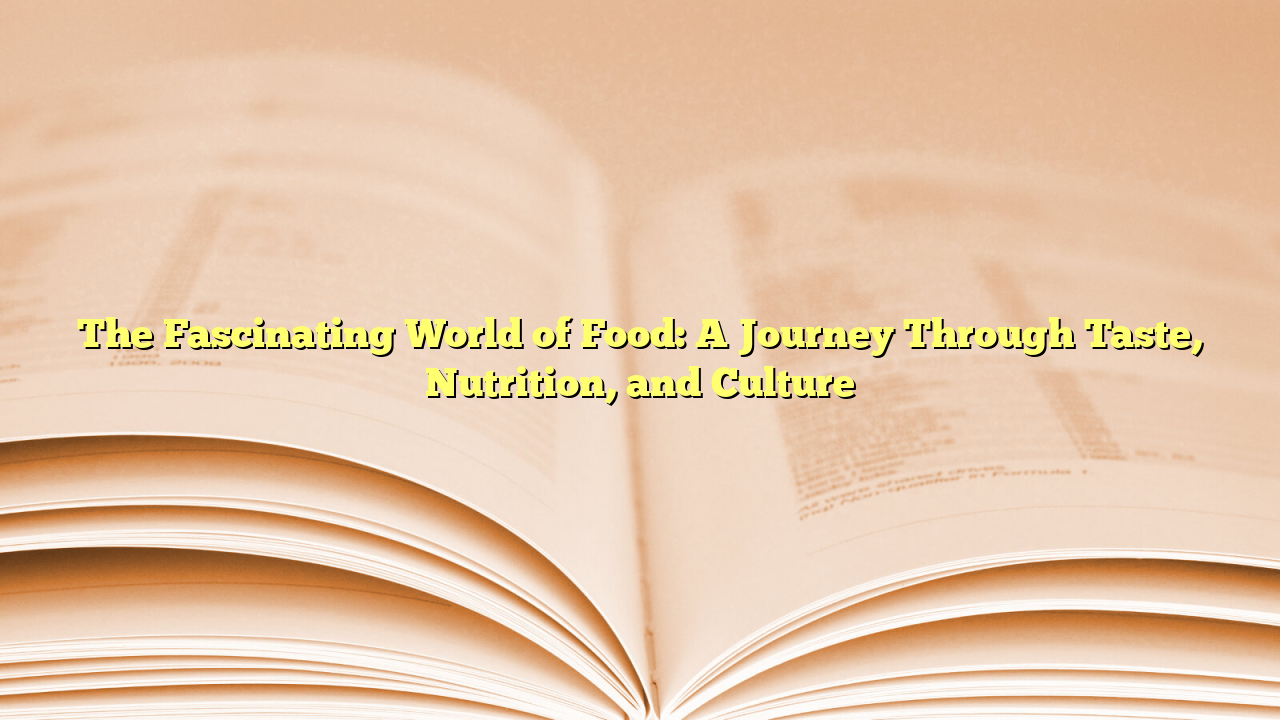Food is much more than just fuel for the body. It is an integral part of our lives, connecting us to our culture, history, and emotions. From the simplest dishes to the most intricate cuisines, food tells a story about where we come from, who we are, and what we value. In this article, we will explore food’s significance across different aspects of life, including its role in nutrition, its cultural importance, and the incredible diversity of flavors that shape the global culinary landscape.
The Nutritional Role of Food
At its most basic level, food provides the nutrients necessary for survival. Humans require six primary nutrients: carbohydrates, proteins, fats, vitamins, minerals, and water. Each plays a vital role in maintaining bodily functions, from providing energy to supporting immune health and cognitive function.
Carbohydrates are the body’s main source of energy. They are found in foods like bread, rice, pasta, and fruits, and are broken down into glucose, which the body uses for immediate energy. In addition to energy, carbohydrates also help maintain blood sugar levels and support digestive health through fiber.
Proteins are essential for building and repairing tissues, as well as producing enzymes and hormones. Sources of protein include meat, fish, eggs, legumes, and nuts. It’s important to consume a variety of proteins to ensure the intake of all essential amino acids.
Fats, though often misunderstood, are necessary for storing energy, absorbing vitamins, and protecting organs. Healthy fats found in foods like avocados, olive oil, and nuts support brain function and promote heart health. Saturated and trans fats, typically found in processed foods, should be consumed in moderation.
Vitamins and minerals are crucial for maintaining various bodily functions. Vitamins like A, C, D, and E support everything from immune health to skin health, while minerals like calcium and iron are essential for bone strength and oxygen transport. These nutrients are abundant in fruits, vegetables, dairy products, and lean meats.
Finally, water is the most important nutrient of all. The human body is composed mostly of water, and it’s required for nearly every bodily function, including regulating body temperature and removing waste. Drinking enough water is essential for overall health.
The Cultural Importance of Food
Food has long been more than just sustenance; it is a cornerstone of cultural identity and tradition. Around the world, food serves as a medium through which we express love, celebrate milestones, and preserve heritage. Traditional dishes passed down through generations serve as a reminder of our roots and a way to honor our ancestors.
Take, for example, Italian cuisine. From pasta to pizza, Italian food is deeply embedded in the country’s culture. Dishes like lasagna, risotto, and tiramisu are not just about flavor but
are celebrations of family, community, and history. Food in Italy is often made with local, fresh ingredients, and the act of cooking and sharing a meal is seen as an expression of love and connection.
Similarly, Japanese cuisine is a perfect example of how food can be intertwined with culture and philosophy. Dishes like sushi, sashimi, and tempura showcase a deep respect for seasonality, balance, and presentation. The Japanese aesthetic of “umami” emphasizes savory flavors and the importance of harmony in taste. Eating in Japan is often a deeply meditative experience, where every ingredient is chosen for its quality, and the meal itself is an act of mindfulness.
In India, food is a reflection of the country’s diversity. Indian cuisine varies dramatically from region to region, with spices, herbs, and flavors unique to each area. For example, North Indian food is known for its rich, creamy curries, while South Indian dishes tend to focus on lighter, more tangy flavors with rice as a staple. Regardless of slot4d , food in India plays a central role in religious and social gatherings. Traditional dishes are often prepared during festivals, where food is offered to deities as a form of worship.
Across Africa, West African cuisine uses a vibrant palette of ingredients like yams, cassava, plantains, and beans, often seasoned with hot peppers, ginger, and garlic. These ingredients are not only nutritious but are symbols of agricultural practices and community sharing. Food in many African cultures is often enjoyed communally, with large family meals celebrating both daily life and special events.
The Global Diversity of Flavors
One of the most exciting aspects of food is the sheer variety of flavors and ingredients that exist around the world. Thanks to globalization and modern travel, people today have the opportunity to explore and enjoy dishes from virtually every corner of the globe.
Mexican cuisine, for instance, offers an explosion of flavors, from the smoky heat of chipotle peppers to the tangy sweetness of lime. Tacos, enchiladas, guacamole, and salsa are just a few examples of the many beloved Mexican dishes. Corn is the foundation of much of Mexican cuisine, appearing in tortillas, tamales, and masa-based dishes, and is a symbol of the country’s agricultural heritage.
In Middle Eastern cuisine, bold flavors such as cumin, coriander, saffron, and cinnamon define dishes like falafel, hummus, and kebabs. The region’s food is often enjoyed in a communal setting, with sharing platters laden with colorful salads, dips, and grilled meats. The use of fresh herbs, yogurt, and olive oil makes Middle Eastern food both aromatic and healthful.
Chinese food is characterized by its balance of flavors—sweet, sour, salty, bitter, and umami—often in the same dish. Dim sum, Peking duck, and stir-fries are popular throughout China and have become beloved staples worldwide. The Chinese emphasis on seasonal ingredients and the art of cooking with a wok creates a diverse array of textures and tastes.
One of the defining traits of food is its ability to bring people together. Whether it’s a simple meal at home, a celebration of a holiday, or a gathering of friends from different countries, food has the power to unite people from all walks of life. It transcends language and cultural barriers, fostering understanding, connection, and shared experiences.
Conclusion
Food is far more than just nourishment—it is a source of joy, tradition, and connection. Through its rich diversity, food offers a window into the cultures, histories, and values of people around the world. Whether we’re savoring a comforting bowl of soup, exploring new international cuisines, or celebrating special moments with loved ones, food holds a central place in our lives, nourishing both our bodies and our souls. As we continue to embrace the flavors and traditions of different cultures, we find that food is not just a necessity, but an extraordinary expression of human creativity and connection.
The Fascinating World of Food: A Journey Through Taste, Nutrition, and Culture



